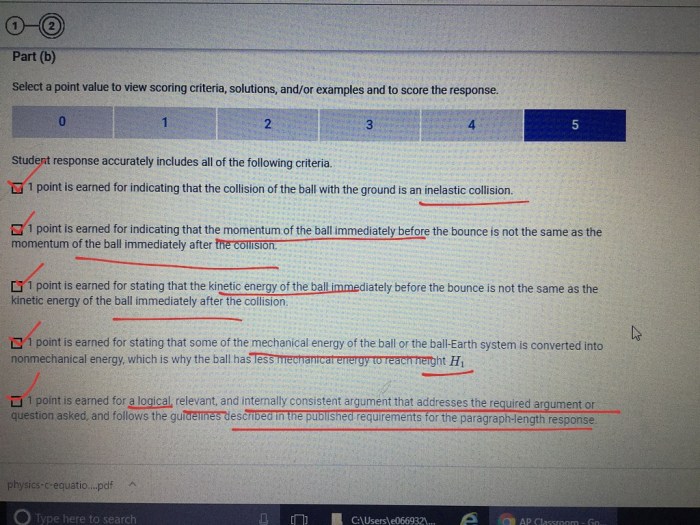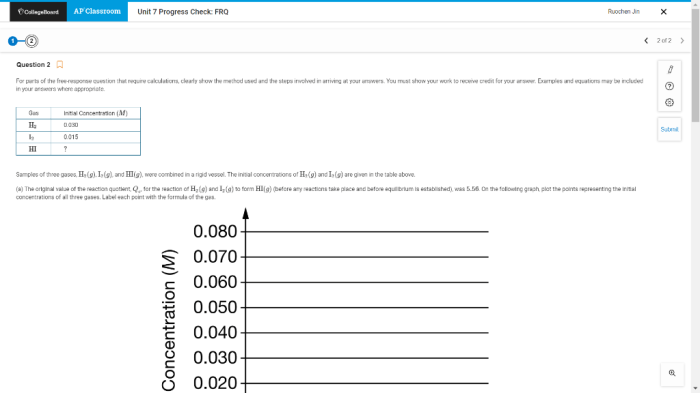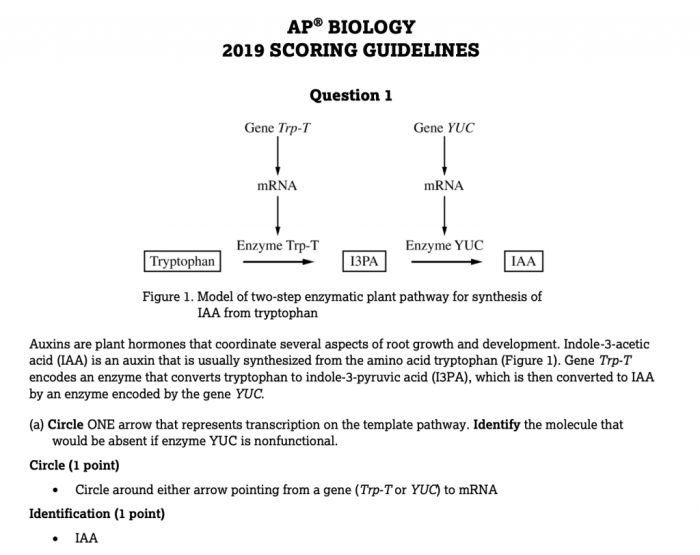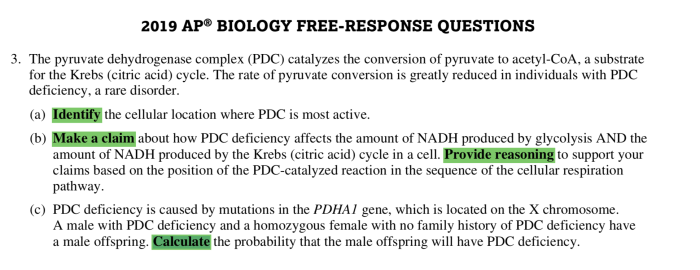Embark on an enlightening journey through AP Bio Unit 7 Progress Check FRQ, where we unravel the intricate mechanisms of gene expression and genetic variation. From the fundamental processes of transcription and translation to the complexities of gene regulation, mutations, and genetic engineering, this exploration promises a profound understanding of the molecular basis of life.
Delving into the heart of gene expression, we will decipher the significance of transcription and translation, the diverse roles of RNA molecules, and the intricate mechanisms of protein synthesis. We will then unravel the intricate web of gene regulation, examining how transcription factors and other regulatory elements orchestrate the precise expression of genetic information.
Key Concepts: Ap Bio Unit 7 Progress Check Frq

The central dogma of molecular biology, which encompasses transcription and translation, serves as the cornerstone of gene expression, the process through which the genetic information encoded in DNA is utilized to produce functional proteins. Transcription and translation are fundamental mechanisms that orchestrate the intricate interplay between genotype and phenotype.
Transcription, the first stage of gene expression, involves the synthesis of RNA molecules using DNA as a template. This process is catalyzed by RNA polymerase, an enzyme that facilitates the formation of a complementary RNA strand based on the DNA sequence.
The resulting RNA molecule, known as messenger RNA (mRNA), carries the genetic information from the nucleus to the cytoplasm, where protein synthesis takes place.
Translation, the second stage of gene expression, involves the decoding of the mRNA sequence to produce a specific amino acid sequence. This process occurs on ribosomes, large molecular machines composed of RNA and protein components. Transfer RNA (tRNA) molecules, each carrying a specific anticodon, recognize and bind to complementary codons on the mRNA.
The ribosome then catalyzes the formation of peptide bonds between the amino acids carried by the tRNA molecules, resulting in the synthesis of a polypeptide chain, the primary structure of a protein.
Types of RNA
In addition to mRNA, there are other types of RNA molecules that play crucial roles in gene expression and cellular function. Ribosomal RNA (rRNA) is a major component of ribosomes and is essential for protein synthesis. Transfer RNA (tRNA) molecules, as mentioned earlier, are responsible for carrying amino acids to the ribosome during translation.
Small nuclear RNA (snRNA) molecules are involved in the processing of mRNA, including splicing and editing.
Mechanisms of Protein Synthesis
Protein synthesis is a complex and highly regulated process that involves several key steps. The ribosome binds to the mRNA molecule and scans the sequence until it encounters a start codon (usually AUG). The ribosome then moves along the mRNA, decoding each codon and catalyzing the formation of a peptide bond between the corresponding amino acids.
As the ribosome progresses along the mRNA, the polypeptide chain elongates. Once the ribosome reaches a stop codon, the translation process is terminated, and the newly synthesized protein is released.
Regulation of Gene Expression

Gene expression, the process by which information from a gene is used to direct the synthesis of a protein, can be regulated at several points. Regulation can occur at the transcriptional level, which is the control of when and where genes are transcribed into messenger RNA (mRNA), or at the translational level, which is the control of when and where mRNA is translated into protein.
Transcriptional Regulation
Transcriptional regulation is primarily mediated by proteins called transcription factors. These proteins bind to specific DNA sequences called promoters, which are located near the start of genes. When a transcription factor binds to a promoter, it can either activate or repress transcription of the gene.Other
regulatory elements that can influence transcription include enhancers, silencers, and insulators. Enhancers are DNA sequences that bind to transcription factors and increase the rate of transcription. Silencers are DNA sequences that bind to transcription factors and decrease the rate of transcription.
Insulators are DNA sequences that block the effects of enhancers and silencers, preventing them from influencing the transcription of nearby genes.
Translational Regulation
Translational regulation can occur through a variety of mechanisms, including:
Control of mRNA stability
The stability of mRNA can be regulated by the presence of specific sequences in the mRNA molecule. These sequences can bind to proteins that either stabilize or destabilize the mRNA, affecting its translation.
Control of translation initiation
The initiation of translation can be regulated by the binding of proteins to the 5′ cap of mRNA. These proteins can either block or enhance the binding of the ribosome to the mRNA, affecting translation.
Control of elongation and termination
The elongation and termination of translation can be regulated by the binding of proteins to specific sequences in the mRNA molecule. These proteins can either block or enhance the movement of the ribosome along the mRNA, affecting translation.
Environmental Influences on Gene Expression
Environmental factors can influence gene expression through a variety of mechanisms. For example, temperature can affect the activity of transcription factors, and the availability of nutrients can affect the stability of mRNA. Additionally, hormones and other signaling molecules can bind to receptors on the surface of cells, triggering intracellular signaling pathways that can lead to changes in gene expression.
Mutations and Genetic Variation

Mutations are changes in the DNA sequence that can affect gene expression. They can be caused by a variety of factors, including environmental toxins, radiation, and errors during DNA replication. Mutations can be either harmful, beneficial, or neutral.
- Harmful mutationscan lead to genetic disorders, such as cystic fibrosis and sickle cell anemia. These mutations can disrupt the function of proteins, which can lead to a variety of health problems.
- Beneficial mutationscan provide an advantage to an organism. For example, a mutation that makes an organism more resistant to a disease can help it to survive and reproduce. Beneficial mutations can eventually become more common in a population through natural selection.
- Neutral mutationsdo not have any effect on an organism’s phenotype. These mutations can accumulate in a population over time and can provide a source of genetic variation.
DNA repair mechanisms help to correct errors that occur during DNA replication. These mechanisms include mismatch repair, base excision repair, and nucleotide excision repair. DNA repair mechanisms are essential for maintaining genetic stability and preventing the accumulation of harmful mutations.Genetic
variation is the difference in DNA sequences between individuals. This variation is the raw material for evolution. Natural selection acts on genetic variation to produce organisms that are better adapted to their environment. Genetic variation is also important for maintaining the health of populations.
It allows populations to adapt to changing environmental conditions and to resist the spread of disease.
Biotechnology and Genetic Engineering

Biotechnology, particularly genetic engineering, encompasses the manipulation of genes and genetic material for various applications. It has revolutionized our understanding of biology and led to significant advancements in medicine, agriculture, and industry.
Recombinant DNA Technology
Recombinant DNA technology is a fundamental technique in genetic engineering. It involves combining DNA fragments from different sources into a single molecule. This allows scientists to create new genes or modify existing ones, leading to the production of proteins with desired traits.Recombinant
DNA technology has numerous applications:
- Production of therapeutic proteins, such as insulin and growth hormone, for treating diseases.
- Development of genetically modified organisms (GMOs) with enhanced traits, such as resistance to pests or herbicides in crops.
- Creation of biofuels and other renewable energy sources.
Methods of Gene Modification, Ap bio unit 7 progress check frq
Gene modification involves altering the genetic material of an organism. Several methods are employed, including:
- Gene Editing:Techniques like CRISPR-Cas9 allow precise modifications to DNA sequences, enabling targeted gene insertions, deletions, or replacements.
- Transgenesis:Introducing foreign genes into an organism’s genome, often through the use of viral vectors.
- Gene Knockouts:Inactivating specific genes to study their function or develop treatments for genetic diseases.
Ethical Implications and Benefits
Genetic engineering raises important ethical considerations, such as:
- Potential risks to human health and the environment.
- Concerns about altering the natural genetic diversity.
- Equity in access to genetic technologies.
Despite these concerns, genetic engineering offers immense potential benefits:
- Development of cures for genetic diseases and treatments for complex disorders.
- Enhanced agricultural productivity, reducing hunger and malnutrition.
- Creation of sustainable and environmentally friendly technologies.
Balancing the ethical considerations with the potential benefits is crucial for responsible and ethical use of genetic engineering.
FAQ Guide
What is the significance of transcription and translation?
Transcription and translation are fundamental processes that convert the genetic information encoded in DNA into functional proteins. Transcription creates an RNA molecule that carries the genetic code from the nucleus to the cytoplasm, where translation uses the code to assemble amino acids into a specific protein.
How do transcription factors regulate gene expression?
Transcription factors are proteins that bind to specific DNA sequences and either promote or repress transcription. They act as molecular switches, controlling the accessibility of the DNA to RNA polymerase, the enzyme responsible for transcribing DNA into RNA.
What are the different types of mutations?
Mutations are changes in the DNA sequence. They can be classified into different types based on their size and effects. Point mutations involve changes in a single nucleotide, while larger mutations can involve deletions, insertions, or rearrangements of DNA segments.
